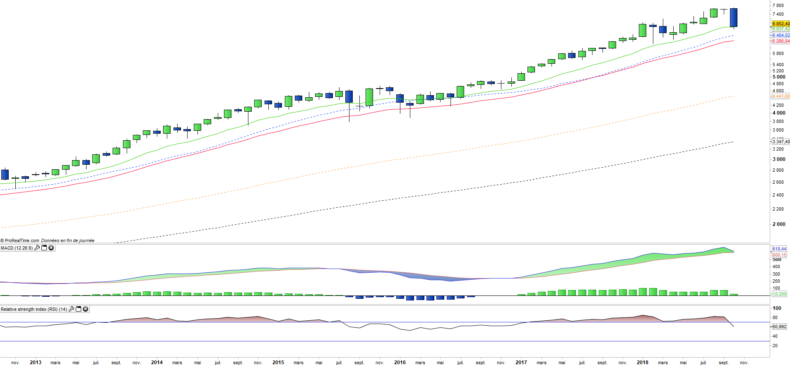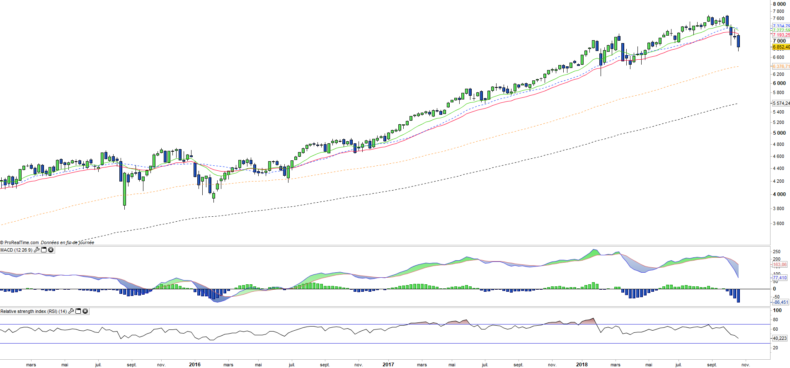Invesco ETF Nasdaq 100 - QQQ - 29/10/2018
Short Term strategy: Negative (30%) / Trend -
Long Term strategy: Positive (90%) / Trend -
Characteristics of the ETF
The QQQ ETF (Powershares), which is quoted in USD on the Nasdaq, replicates the Nasdaq 100 index which is composed of the top 100 non-financial US stocks, mainly in the technology sector and listed on the Nasdaq, selected according to the importance of their market capitalization.
The ETF fees are 0.2% and the AUM is very high at $66bn. Replication is direct (physical) and there is a dividend distribution policy.
Alternative ETFs: ANX (Amundi in Euro), UST (Lyxor in Euro), CNDX (iShares in USD)
Latest developments
The Nasdaq100 rose by 31.5% in 2017, the largest annual increase since the 2009 rebound, and the increase continues in 2018 (+ 7.3% since the beginning of the year) despite a sharp correction in process especially in the semiconductors and GAFAs.
Amazon is now 20% below its peak but still progresses by + 40% since the beginning of the year, Google is 16% below its peak and is almost at equilibrium, while Facebook is at 33% of its peak and has fallen by 18% since the beginning of the year. Only Apple remains close to its highs and shows good resistance ahead of its third quarter results.
This consolidation essentially corresponds to sustained profit taking, after quarterly results slightly below expectations, and especially an increasingly worrying context because of D. Trump's trade war against China which could have consequences on margins ofmajor players, particularly in semiconductors but also in other segments. In addition, the rise in long-term rates and a greater restriction of liquidity by the FED is also pointing towards a thorough correction.
Index & components
The top 10 stocks in the index, including Apple, Amazon, Alphabet, Facebook and Microsoft, account for about 57% of the market capitalization of the index, while Apple alone accounts for 13,3% of the index.
The interest of this index lies in the fact of taking a diversified bet but concentrated on the most beautiful technological stocks, giving a good share to the "GAFA" (Google, Apple, Facebook and Amazon) which represent 37% of the capitalization. The index is particularly influenced by Apple's prices, which fluctuate according to the success of its new smartphones.
Note that large technology stocks have generally performed very well in 2017, especially GAFA but also semiconductors (Intel) and Microsoft. Large biotech stocks such as Gilead and Amgen have bounced back recently after a long period of wavering. However, the attractiveness of US biotech companies remains significant at a national level, and these are prime targets for major US laboratories, as well as an alternative to transcontinental operations.
The volatility of the index is not very marked, which reflects the considerable weight of market capitalizations often above $ 300 billion for the top 10 companies, see $ 500 billion for the top 5.
But the Nasdaq 100 is not just about its top 10 stocks, and the depth of the index makes it possible to invest in companies that are already established but still have a strong appreciation potential like Tesla, Xilinx or Symantec.
The hegemonic position of the GAFA in the world begins to provoke reactions, especially in Europe, both on competitive positions or abuse of dominant positions could trigger heavy fines, as for Google (€4.3bn fine by the EC), but also on taxation while European countries seek to find an agreement to tax the revenues generated on their territory.
Chinese competitors are becoming more and more present, such as Alibaba or Tencent, and could soon threaten the supremacy of the leaders of American technology.
Monthly data
The monthly chart shows a very large negative candlestick in the month of October which corresponds to a fall of 10% a few days before the end of the month. This candlestick should leave traces, and after a technical rebound, a second leg down towards the EMA26 is quite likely. The reversal of the long-term trend is not confirmed, but it is possible because of the brutality and depth of the downward attack, which is out of proportion to the February 2018 correction.
Weekly data
On the weekly chart we can see the overflow of moving averages by prices and a dangerous narrowing of moving averages that threaten to cross. The crossing of the EMA13 & 26 is potentially the next step of the correction. If confirmed, the correction will look like a medium-term or even a long-term bearish reversal. A rebound that would not allow a recovery above the averages will have to be leveraged to sell long positions.
ETF Objective
QQQ is an ETF listed in USD, which seeks to replicate the Nasdaq 100 Index (103 US companies)
Characteristics
| Inception date | 10/03/1999 |
| Expense ratio | 0,2% |
| Benchmark | Nasdaq 100 |
| Issuer | Invesco |
| Ticker | QQQ |
| ISIN | US73935A1043 |
| Currency | $ |
| Exchange | Nasdaq |
| Assets Under Management | 65 785 M$ |
| Replication Method | Direct (Physical) |
| Dividend | Distribution |
| Currency Risk | No |
| Number of Holdings | 103 |
| Risk | 3/5 |
Country Breakdown
| USA | 100% |
Sector Breakdown
| Information technology | 44% |
| Telecom services | 22% |
| Consumer discretionary | 16% |
| Health Care | 9% |
| Consumer Staples | 6% |
| Industrials | 2% |
Top Ten Holdings
| Apple | 13% |
| Amazon | 10% |
| Microsoft | 10% |
| Alphabet | 9% |
| 4% | |
| Intel | 3% |
| Cisco | 3% |
| Comcast | 2% |
| PepsiCo | 2% |


